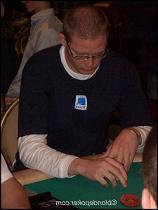 Stage 3 – The Bubble
Stage 3 – The Bubble So you’ve survived the middle game and got down to the final 4, which you should be doing just over half the time. There are 3 prizes and one poor sod will get nothing. Players get nervous now and tend to tighten up too much; you can exploit this and attack their blinds.
How you play now is extremely important to your success as an STT player. Bubble play is very tactical and good players exploit the situation to put themselves in powerful positions for the end game.
Once again your play will largely be dictated by your stack size. Now, however, it's your stack size relative to the other players rather than the blinds that is most important.
You don’t have to be raising all-in every time now, but it will still be the default play. There will be very few flops and one raise will take the blinds most often. I like to raise 1½ to 2 times the big blind, if I have enough chips, the medium stacks will rarely call or reraise without big hands and you can attack them mercilessly
If there is no dominant stack, or if you already have the biggest stack, you can pick up a lot of chips here and take control of the game. Of course this can go wrong very swiftly, if you run into a hand or two you will find yourself very short or bust pretty quickly. Most of the time however you will build your stack enough to give you a good chance of winning the tourney. If you have a massive stack and all the others are tiny then it is often best to let them fight it out amongst themselves. If they raise your BB and you'r getting 2/1 or better odds, you can call with any two.
If you are the shortest stack then you need to get your chips in fast before the blinds gobble you up. Try to get your chips in first with anything reasonable and pray. You will double up, bust or, if you take 2 or 3 pots uncontested, then you might have shuffled up a place.
If you are one of 2 or 3 shortstacks and have position on the others, then you can afford to wait to see if they bust out first. If they have position on you then you need to attack them, when you have the opportunity.
If you have a medium stack and are not in immediate threat from the blinds then you can wait to see if one of the shortstacks busts out before you become too active. You can attack any other medium stacks, but leave the bigger stacks and the shortstacks alone unless they are very tight. In this situation you are at the mercy of the big stack. Fortunately, they are often merciful. You can’t always call the shortstacks' all-ins even when you have the odds. If it’s going to hurt you too much sometimes you have to pass.
There are charts available which give you the expected value of pushing and calling with different ranges of hands, in these types of situations. I personally don’t use them. I prefer to use a bit more feel, but if you play on a site that’s compatible with a tracker that gives you the calling and pushing ranges of your opponent then I can see how these would be useful, especially for multi-tablers.
Stage 4 – Just Win, Baby!
Well done, you’ve achieved your primary objective and made some money, but no one remembers who finished 2nd or 3rd, let’s win it!
Normally at this stage the blinds are usually colossal and it’s a bit of a crapshoot. Try to be the most aggressive player and adapt to your opponents' style. If you’re playing with familiar foes then learn their betting patterns. Most players will either be too aggressive and you can trap them or too tight and you can raise them out of the game.
Winning lots of small pots is usually preferable to trying to scoop the lot in one go, but if the blinds are very big and your opponents are capable of outplaying you then sometimes it is best to just shovel your chips in and hope for the best.
to be continued...